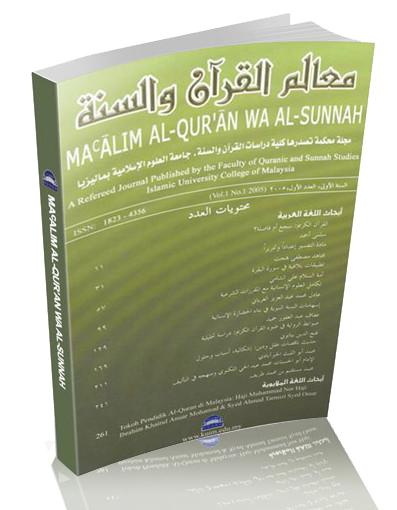Vektor Zika dan Teknik Kawalan Haiwan Perosak Menurut Perspektif Hadis
The Perspective of Hadith on Zika Vector and Pest Control Techniques
DOI:
https://doi.org/10.33102/jmqs.v14i1.119الكلمات المفتاحية:
Mosquito, Zika, pest control, hadith, fasiq animal, nalogyالملخص
The spread of Zika virus (ZIKV) has raised tensions among the world community especially Malaysia since it was last recorded in 2007. Zika (ZIKV) is transmitted to humans by the Aedes Aegypti mosquito which also causes dengue, chikungunya and yellow fever. In less than a year, the Zika virus has spread across the globe. The focal point was on February 1, 2016 when World Health Organization (WHO) had to press the panic button and declare ZIKV a Public Health Emergency of International Concern (PHEIC). All significant world health agencies have now been deployed for the purpose of preventing and controlling viruses. A range of appropriate control measures have been implemented including the repellent campaign against Aedes mosquito and to monitor the flow of people and international tourists to Malaysia. Significantly, in the compilation of his word, Prophet Muhammad has warned of the dangers and threats of pests. Although mosquitoes are not specifically referred to as fasiq animals (pests), their threats could qualify to be classified as pests through the opinion of qias (analogy) scholars. Therefore, this paper seeks to shed light on the threat of mosquitoes and the basis of their relationship to the fasiq animals (pests). This study is important in guiding the community concerning the harm produced by animals and the finest control procedure in light of the sunnah of the Prophet.
المراجع
‘Ali Ibn Adam Ibn Musa al-Ityubi al-Wallawi (1996), Sharh Sunan al-Nasa’i al-Musamma Dakhirah al-‘Uqba fi Sharh al-Mujtaba, Riyadh: Dar al-Mi’raj al-Dawliah lil Nashr.
Abd Latif Muda, Rosmawati Ali @ Mat Zin (2000), Perbahasan Kaedah-Kaedah Fiqh, Kuala Lumpur: Pustaka Salam Sdn. Bhd.
Abu ‘Abd Allah Muhammad Ibn Muhammad Ibn Yusuf al-Sanusi al-Hasani (t.t.), Mukammil Ikmal al-Ikmal Sharh Sahih Muslim, Beirut-Lubnan: Dar al-Kutub al-‘Ilmiah.
Abu al-Tayyib Muhammad Syams al-Haq al-‘Azim Abadi (1968), ‘Aun al-Ma‘bud Sharh Sunan Abu Dawud, Madinah al-Munawwarah: al-Maktabah al-Salafiah.
Ahmad Ibn ‘Ali Ibn Hajar al-‘Asqalani (2001), Fath al-Bari bi Sharh Sahih al-Bukhari, Riyadh: Fahrasah Maktabah Malik Fahd al-Wataniah Ithna’ Nashr.
al-Fakhr al-Raziy (1995), al-Tafsir al-Kabir, Beirut: Dar Ihya’ al-Turath al-`Arabiy.
al-Zamakhshariy (1995), al-Kashshaf, Beirut: Dar al-Kutub al-`Ilmiyyah.
Anis, Ibrahim et.al., (t.t.), al-Mu`jam al-Wasit, t.tp: t.p.
Buletin Online (2016), WHO Isytihar Virus Zika Sebagai “Darurat Kesihatan Global”, 4 Februari 2016.
Cameron E. Webb (2011), Beating the Bite of Mosquito-Borne Disease: A Guide to Personal Protection Strategies Against Autralian Mosquitoes, Australia: University of Sydney and Westmead Hospital.
D. Tappe, et al., (2014), First Case of Laboratory-Confirmed Zika Virus Infection Imported Into Europe, Euro Surveill., 19 (4), 54-57.
E. Oehler, et al., (2014) Zika Virus Infection Complicated by Guillain-Barre Syndrome – Case Report, French Polynesia, December 2013, Euro Surveill., 19 (9), 58-60.
Haqkiki Harfiani (2012), Efektivitas Larvasida Ekstrak Daun Sirsak Dalam Membunuh Jentik Nyamuk, Jurnal Kesehatan Masyarakat (KEMAS), 7 (2), 164-169.
Ibn Hajar al-‘Asqalani (2006), Fath al-Bari bi Sharh Sahih al-Bukhari, terj. Amiruddin et al., Jakarta: Pustaka Azzam Penerbit Buku Islam Rahmatan.
Ibn Manzur (t.t.), Lisan al-‘Arab, Kaherah: Dar al-Ma’arif.
Kenyataan Akhbar Datuk Dr. Noor Hisham Abdullah (2015), Ketua Pengarah Kesihatan (KPK) Malaysia, Pemantauan Virus Zika Oleh Kementerian Kesihatan Malaysia, 4 Disember 2015.
Kosmo Online (2016), Aedes Pembawa, Penyebar Zika, 4 Februari 2016.
Malaysiagazette.com (2016), Wabak Zika: Elak Melancong Ke Amerika Selatan, 31 Januari 2016.
Mary Kay Kindhauser, et al., (2016) Zika: The Origin and Spread of a Mosquito-Borne Virus, Bull. World Health Organization, 1-18.
Mohamed Salleh (1997), Rahsia Pengungkapan Serangga Dalam al-Qur’an, Kuala Lumpur: Jabatan Kemajuan Islam Malaysia.
Mohd Farhan Md Ariffin (2015), “Analisis Hadith Mengenai Haiwan Fasiq dalam Al-Kutub Al-Sittah: Kajian Terhadap Persepsi Masyarakat Melayu Di Daerah Pengkalan Hulu, Perak” Disertasi Ijazah Sarjana, Jabatan al-Qur’an dan al-Hadith, Akademi Pengajian Islam, Universiti Malaya, Kuala Lumpur.
Monika@Munirah Abd Razak dan Nik Mohd Zaim Ab Rahim (2011), “Hadith-Hadith Mengenai Anjing: Tumpuan Kepada Isu Pemeliharaan Dan Pengharamannya Daripada Perspektif Hadith Ahkam,” dalam Seminar Antarabangsa Sunnah Nabawiyyah: Realiti Dan Cabaran Semasa (MUSNAD I), ed. Fauzi Deraman, Ishak Suliaman dan Faisal Ahmad Shah, Jabatan al-Quran & al-Hadith, Akademi Pengajian Islam, Universiti Malaya, 526-532.
Muhammad ‘Abd al-Rahman Ibn ‘Abd al-Rahim al-Mubarak Furi (t.t.), Tuhfah al-Ahwadhi bi Sharh Jami’ al-Tirmidhi, t.tp., Dar al-Fikr lil Taba‘ah wa al-Nashr wa al-Tawzi’.
Norhibah Hasan Zawawi (1999), Konsep Islam Terhadap Pemuliharaan Alam Sekitar, Kuala Lumpur: Jabatan Kemajuan Islam Malaysia.
Northern Territory Government (2014), Centre for Disease Control, June 2014.
Utusan Online (2015), Kementerian Kesihatan Giat Pantau Virus Zika, 2 Disember 2015.
World Health Organization (1995), Vector Control for Malaria and Other Mosquito-Borne Diseases, WHO Technical Group Series.
Yahya Ibn Sharf Al-Nawawi (1930), Al-Minhaj Sharh Sahih Muslim, Mesir: Dar Ihya’ al-Turath al-‘Arabi.
Yahya Ibn Sharf Al-Nawawi (1969), Sahih Muslim bi Sharh al-Nawawi, Riyadh: al-Matba`ah al-Misriah.
Yusuf al-Haj Ahmad (2003), Mawsu`ah al-I`jāz al-`Ilmiy fi al-Quran al-Karim wa al-Sunnah al-Mutahharah, Damsyik: Maktabah Ibn Hajar.
Yusuf al-Qaradhawi (1997), Fiqih Peradaban Sunnah Sebagai Paradigma Ilmu Pengetahuan, Surabaya: Dunia Ilmu.
التنزيلات
منشور
كيفية الاقتباس
إصدار
القسم
الرخصة
الحقوق الفكرية (c) 2018 مجلة معالم القرآن والسنة

هذا العمل مرخص بموجب Creative Commons Attribution 4.0 International License.
The copyright of this article will be vested to author(s) and granted the journal right of first publication with the work simultaneously licensed under the Creative Commons Attribution 4.0 International (CC BY 4.0) license, unless otherwise stated.
Authors are able to enter into separate, additional contractual arrangements for the non-exclusive distribution of the journal's published version of the work (e.g., post it to an institutional repository or publish it in a book), with an acknowledgement of its initial publication in this journal.
Authors are permitted and encouraged to post their work online (e.g., in institutional repositories or on their website) prior to and during the submission process, as it can lead to productive exchanges, as well as earlier and greater citation of published work.









